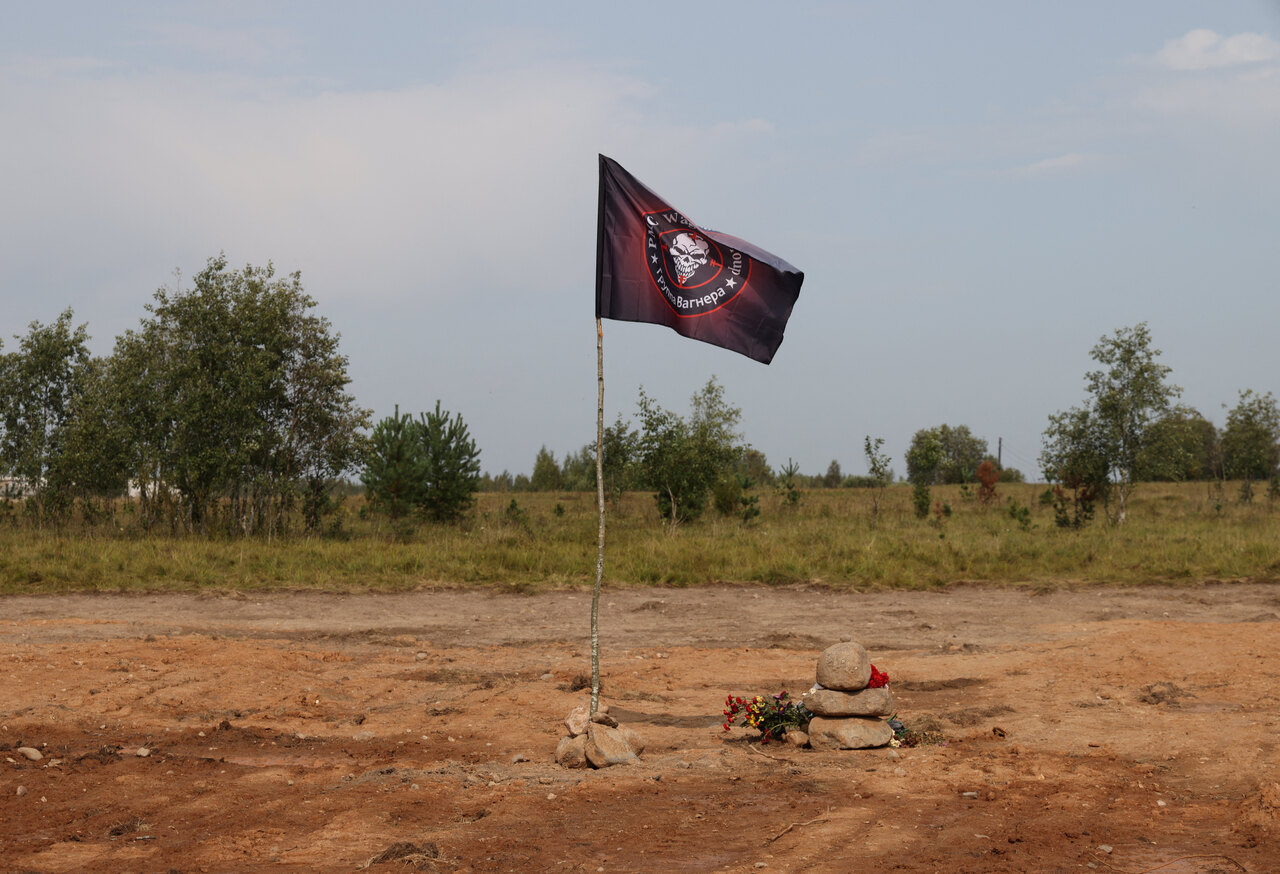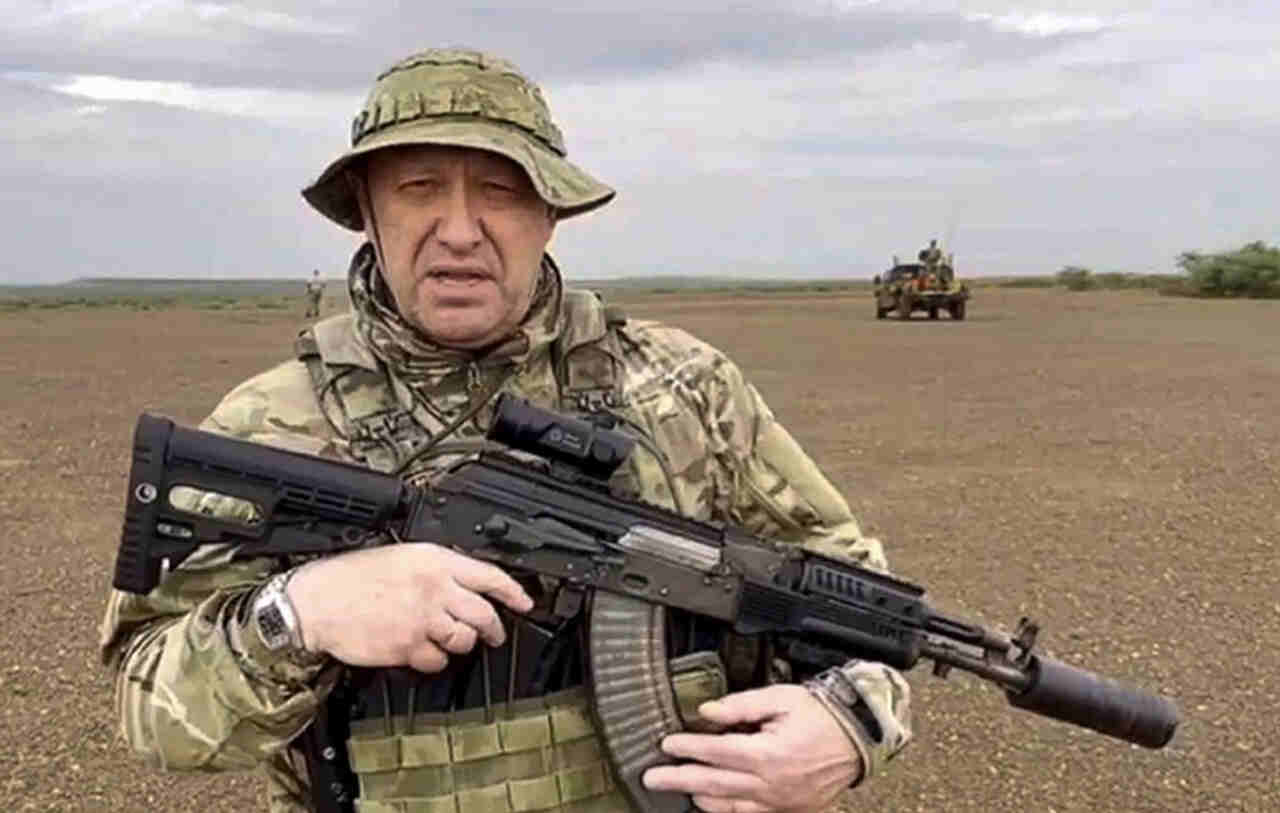Wagner Group in Belarus: What are the Consequences for NATO and the EU?
The death of the head of the Wagner Group, Yevgeny Prigozhin, along with the group’s main commander, Dmitry Utkin, in a plane crash on 23 August could accelerate the military company’s reorganisation. Regardless of the scope of the changes, some of its mercenaries will remain in Belarus and will be used to foster threats to NATO and EU countries. To reduce the effectiveness of their actions, the most threatened countries, including Poland, should treat the group as a terrorist organisation, which can facilitate the coordination of actions within NATO and the EU against such groups.
 OBTAINED BY REUTERS / Reuters / Forum
OBTAINED BY REUTERS / Reuters / Forum
Russian mercenaries of the Wagner Group arrived in Belarus in July as a result of arrangements between Aleksandr Lukashenka and Vladimir Putin to resolve the crisis caused by the “Prigozhin rebellion”. After the plane crash, Lukashenka announced that, despite Prigozhin’s death, the Wagner Group would remain in Belarus and the number of fighters would be increased from 4,000 to 10,000. Their unclear legal status, combat experience, and international attention give Belarus and Russia an additional instrument of hybrid influence in the grey zone of state activity where it is difficult to assess the nature of the threat and assign clear responsibility for various forms of aggression. Russia and Belarus use hybrid actions to create a sense of threat and increase political tensions in NATO and the EU, especially in countries on the Alliance’s Eastern Flank. They hope that this will deepen the divisions between Western allies as to the nature and scope of the threat and possible consequences, which will make it more difficult and costly for the Alliance to respond.
The Future of the Wagner Group
The death of the group’s leaders will prompt further reorganisation, but will not significantly reduce its threat to NATO and the EU from Belarus. Initially composed of several thousand mercenaries, the Wagner Group was used by the Russian authorities primarily to destabilise eastern Ukraine and then to strengthen Russia’s influence in the Middle East and Africa. After the start of the full-scale Russian war against Ukraine, the mercenaries began to operate alongside the regular armed forces, and thanks to recruitment in prisons, their numbers increased to about 50,000. The capture of Bakhmut, which resulted in high losses (about 20,000-30,000 Wagner fighters were killed), increased the importance of the mercenaries and strengthened Prigozhin, who tried to prevent the group from being subordinated to the Russian armed forces. Fearing for the future of the organisation and his own position in the regime’s power structures, Prigozhin intensified his criticism of Minister of Defence Sergei Shoigu and Chief of the General Staff Gen. Valery Gerasimov, accusing them of incompetence before taking action intended to force their dismissal. In an act of rebellion, the mercenaries entered and effectively occupied Rostov-on-Don, where the headquarters of the Southern Military District are located. Putin’s lack of reaction to the takeover prompted Prigozhin to announce a “march on Moscow”, which was publicly deemed by the Russian leader as treason.
An agreement negotiated with the support of Lukashenka to end the crisis, included a provision that some of the rebels could move to Belarus, while the rest would be subordinated to the Ministry of Defence or cease activities. According to independent analyses, about 4,500 of the mercenaries went to Belarus. Officially, their task is to train Belarusian soldiers and units of the Ministry of Interior. Regardless of whether some of the mercenaries can actually be used for such tasks, their presence also gives new opportunities to influence the threat perception of NATO and EU countries. For the Belarusian regime, which rigged the 2020 elections and was subject to international sanctions, the ability to influence NATO and EU countries is an important political instrument. Belarus, which together with Russia forms a Union State and relies on Russian security guarantees, primarily uses the presence of Russian troops on its territory to increase threats to NATO and the EU. However, Lukashenka fears the stationing of too many Russian troops on his territory, which is why he willingly accepted the mercenaries, hoping that he would be able to control their activities. This solution was also beneficial for Russia, as it may enable the withdrawal of some of its troops from Belarus, while retaining the possibility of using its territory to increase threats to NATO and EU countries.
The death of the Wagner leaders makes it easier for the Russian Ministry of Defence to take control of the organisation and reorganise it further. The main changes may be limited to appointing new leadership and subordinating the previously semi-independent mercenaries to the Ministry of Defence. It is also possible that other semi-private (state-funded but highly autonomous) mercenary organisations in Russia (e.g., Redut, Patriot, Convoy), which on 1 July were put under the control of the armed forces, will partially or completely take over Wagner’s assets and activities. Representatives of the Ministry and military intelligence are already taking steps to subsume Wagner assets in Africa. Shoigu threatened countries using Wagner’s services that Russia would break military-technical cooperation and withdraw support in the UN Security Council if they did not sign contracts with other mercenary companies controlled by the Ministry of Defence. The dissolution of the Wagner Group, which had gained a considerable reputation in Africa and the Middle East, would be a blow to Russia’s image there, but it will not undermine its ability to pursue strategic goals in these regions.
At the same time, it is in the interests of both Russia and Belarus to retain influence on the threat perception of NATO and EU countries through the presence of the mercenaries at their borders. Irrespective of the future of Wagner, the presence of its fighters will be used for psychological and disinformation activities. Although the elimination of Wagner’s leaders may temporarily reduce the effectiveness of psychological influence operations, the mere presence of several thousand mercenaries remains an additional risk factor for NATO and EU border states to consider. Intense provocations involving these fighters may also be used to strengthen their credibility and image.
Possible Actions of Wagner Mercenaries Against NATO and EU Countries
Belarus and Russia can use the Wagner fighters to attack security services and barriers protecting the border between Belarus and NATO’s Eastern Flank countries, to increase migration pressure on Poland, Lithuania, Latvia, and the EU, to include agents among the migrants, or to engage in sabotage and reconnaissance. Information about increasing number of mercenaries and their activities close to the borders, but also potentially on the territory of NATO and EU countries, will be an element of psychological and disinformation activities. The sense of threat (e.g., more than 50% of Poles perceive the presence of Wagner members in Belarus as a threat) may be increased, for example by reports that Belarus is issuing passports to the mercenaries or supposed recruitment in Poland and Lithuania.
Since the Wagner fighters moved to Belarus without heavy warfare equipment, at this stage it does not pose a real military threat to NATO border states (Poland, Lithuania, and Latvia) as an independent armed formation. However, the mercenaries in Belarus may be used to support such threats in the future. Transforming some of them stationed in Belarus into regular armed units under Russian command and/or incorporating them into the Regional Group of Forces (joint forces of Belarus and Russia) would increase the possibilities of carrying out military operations from the territory of Belarus against Poland, Lithuania, and Latvia. Provocative actions by Wagner fighters may be carried out in parallel with the increasing military potential of Belarus and Russia on the eastern borders of the Alliance. Such provocations should be expected and countered during large Russian-Belarusian exercises.
Even if the Wagner fighters do not currently pose a military threat, their presence on NATO’s borders offers new opportunities to convince some members of the Alliance that there is an increased risk of war between the Union State and the Alliance. As Russia’s military potential has been weakened by the war in Ukraine, it is harder for Russia to threaten NATO and the EU with full-scale military aggression. However, the activities of the Wagner mercenaries near NATO borders, such as participation in regular exercises of the armed forces at training grounds near the border with Poland and Lithuania, create the opportunity to provoke incidents that could cause an uncontrolled escalation.
This was probably the purpose of the violation of Polish airspace by Belarusian military helicopters at the beginning of August this year, during an intensified period of an information and psychological campaign touting the Wagner fighters’ presence in Belarus. Through coordinated messaging, Putin and Lukashenka are trying to increase the credibility of a scenario in which an incident at the border could lead to major escalation and war. The Russian president claimed, among other things, that Poland has aggressive plans involving Belarus and that Russia is ready to defend it. Lukashenka warned that the Wagner fighters want to enter Polish territory, but “he is stopping them from doing so”. Both statements are a clear warning that the mercenaries could be used for a provocation to force a disproportionate response from NATO and EU border states, which in turn could lead to a reaction from Russia. In this way, Russia and Belarus are trying to raise fears in NATO countries of an escalation, which in turn would lead to confrontation between NATO and Belarus and, consequently, to the outbreak of a conflict between Russia and the Alliance. Fears of such a conflict have been expressed many times, including by U.S. President Joe Biden, and are so strong that they have affected the scale and pace of support from the U.S. and other NATO countries for Ukraine as it defends itself from Russia. The assessment of the risk associated with such a scenario may be additionally influenced by the deployment of Russian nuclear weapons on Belarusian territory, which, according to the Russian and Belarusian authorities, has already begun.
The Reaction of the Eastern Flank Countries, NATO, and the EU
Poland, Lithuania, and Latvia are the countries most exposed to provocations from the Wagner fighters from the territory of Belarus. They have taken measures to deter Belarus and Russia from provocations intended to escalate the tense situation, reduce their effectiveness, and strengthen their sense of security. Poland announced reinforcement of its Border Guard with several hundred police (including counter-terrorist units), the deployment of additional armed forces on the border (up to 4,000) and the creation of a special task force (6,000 soldiers) maintained in reserve. Lithuania temporarily closed four out of six border crossings with Belarus, in part due to the risk of infiltration of its territory by Wagner fighters using Belarusian passports. The countries of the region also have tried to strengthen strategic communication through coordinated messages in order to increase political pressure on the Belarusian authorities. Poland, Lithuania, and Latvia have warned that they could completely close the border with Belarus, which would cut it off from the possibility of trade with the European Union, which, despite the sanctions imposed on Belarus, remains its second-largest trade partner, after Russia. Together with Estonia, they also called on the Belarusian authorities to immediately remove the Wagner forces from its territory, as well as to pull back migrants from border areas and return them to their countries of origin.
A coordinated response at the NATO and EU levels may have been hampered by differences in the threat assessment. Parliaments in Lithuania, Estonia, Canada, and France have already designated the Wagner Group as a terrorist organisation (the United Kingdom is considering it). The U.S., on the other hand, labels the Wagner Group as a “transnational criminal organization”, a status that emphasises the business, not military, dimension of its activity. Coordinated action may be further complicated by NATO’s strategy, which assumes that responsibility for combating hybrid threats rests primarily with the member states. NATO only announced in its communiqué from the Vilnius summit that it would remain vigilant and monitor the deployment of the quasi-private military organisations in Belarus. The Alliance may have considered the actions taken by the states as sufficient, but it cannot be ruled out that the apparently restrained reaction was influenced by concerns about the risk of escalation. The EU, which has imposed sanctions on the Wagner Group for human rights violations in Africa, Syria, and Ukraine, stated that it was concerned about the relocation of the mercenaries to Belarus and the associated threat to the stability of the region and Belarusian sovereignty. The only significant form of strategic communication that supported the eastern NATO and EU states and could strengthen deterrence was a statement by the U.S. ambassador to the UN, who warned on 31 July that the Russian authorities bear full responsibility for the activities of the Wagner forces in Belarus.
Conclusions and Recommendations
• The death of the Wagner Group leaders will make it easier for Russia and Belarus to control the organisation and use it to create direct threats to NATO and EU countries. The unclear status and future of the Wagner Group, the problem of defining the nature of the threat, and concerns about escalation may make it difficult for NATO and the EU to deter Russia and Belarus from using the mercenaries for such activities.
• Poland can increase its ability to counter threats from the Wagner Group by recognising it in a resolution in parliament as a terrorist organisation. This would increase the chances of a coordinated NATO response in the event of the use of the mercenaries for subversive activities such as sabotage and attacks on critical infrastructure. This would make it possible to act based on the Alliance’s new defence plans, which take into account both military threats from Russia and terrorism. Responding to the terrorist threat does not preclude the possibility of acting on plans regarding the threat from Russia if its aggressive actions are accompanied by increasing military potential at NATO’s borders. It also provides the opportunity for more diversified actions while limiting the risk of escalation.
• It is also in Poland’s interest to seek the recognition of the Wagner Group as a terrorist organisation, sponsored by Russia, by both the EU and the UN. This would expand the possibilities of individual EU countries to combat and counteract the group and/or its fighters. It would also increase the possibility of imposing sanctions on entities previously associated with Prigozhin (more than 60 companies) and would make it more difficult for other oligarchs and their quasi-private military companies to take over these assets, limiting their ability to continue destabilising activities, in particular in Africa. Recognising the Wagner Group as a terrorist organisation and potentially other similar entities in the future would give new opportunities to exert diplomatic pressure on countries that support such forces (e.g., Belarus) or use their services (e.g., Libya, Mali, Central African Republic). It could also discourage other countries (e.g., China) from supplying mercenaries with military equipment. Limiting the freedom of action or eliminating the presence of the Wagner Group (or its potential successors) in Africa would weaken Russia’s ability to finance the war in Ukraine from the exploitation of African natural resources (including gold, oil, diamonds, and timber).
• EU recognition of the Wagner Group as a terrorist organisation could influence the Russian authorities to finally dissolve the organisation, which would be a blow to Russia’s image in parts of the world and a success for Western countries. It would strengthen the EU’s credibility and facilitate the fight against other quasi-private military organisations that are in effect run by the Russian authorities.





.jpg)
(1).jpg)
